

“The Mayan artist was most interested in abstractions. The use of line, volume, and color for non-descriptive, highly intellectualized purpose, was as natural with him as an objective fidelity is to the camera. As a result, this art stands as one of the wealthiest mines of theological motives and plastic abstractions the world has ever known.”
–Art From the Mayans to Disney by Jean Charlot. Sheed and Ward, NY & London, 1939. *See note below


dated to AD 731. Click image to enlarge.
One of the last great military rulers of the city of Calakmul, his name reflects his connection to the powerful Lightning God K’awiil (see below). Dressed in royal cape and snake headdress, he brutally stands on a captive from the rival city of Tikal. This is one of the few existing Maya monuments that includes the names of the sculptors in the incised text: Sak[…] Yuk[…} Took’ and Sak[…] Tib’ah Tzak B’ahlam.Roaming this large, immersive exhibition at New York’s Metropolitan Museum of Art, my Animated Eye marvels at the variety of graphic styles, materials, and visual storytelling techniques displayed in 120 rarely seen masterworks of the Mayan Classic period (A.D. 250-900). Abstraction is but one graphic means employed by highly accomplished (mostly anonymous) artists who visually communicated the power of Mayan deities, and their close links with royal leaders of the Maya court, who interacted with the supernatural world. Towering limestone carvings and small sculptures, line drawings on cylinder vessels and pottery, decorative ornaments, figurines, wall murals, and masks offer both realistic draftsmanship and sophisticated caricatures that often mingle with intricate, grotesque phantasmagoric designs.
Beginning 4,000 years ago in Mesoamerican rain forests, the ancient Maya built a sophisticated, complex society populated by artists and scribes, astronomers, mathematicians. They were also brutal, vengeful warriors. Bloodletting, of oneself or a prisoner of war, was based on widespread Mesoamerican religious beliefs.
The Maya ruler’s role on earth was as the embodiment of, and chief communicator with, dozens of gods, who could appear old or young in human and animal form. The rulers of the city-state often included women as warrior-queens and powerful priestesses. The numerous deities of the supernatural world profoundly influenced every aspect of the natural everyday world of the ancient Mayans. The visualizations of 9th Century Mayan art — fearsome, fanciful and sensual – still evoke emotions of awe, humor and horror in 21st Century viewers.
Recent discoveries have made new inroads into deciphering Mayan glyphs, phonograms, and visualizations; but much more information needs to be discovered. However, universal communication principles, actions and emotions can be ascertained through these silent artworks in their presentation of basic body language, design, composition and symbolism. As an animator and archaeology fan, I’m intrigued by the mystery, beauty, imagination and humor found in Mayan artworks. Here are random thoughts about a selection of artworks in the Met exhibition that particularly caught my eye.

Corn was the Maya’s most important food, so no god was more important than the Maize God. Over the centuries, artists changed his appearance as he developed from birth (planting) to maturity (humans tending the crop) to death (harvesting). However, his portraits consistently include a long, curved head (like a corncob) with hair adorned by seeds and foliage. This nearly life-size limestone bust is one of twenty Copan temple adornments of the Maize God as a beautiful young man, foliated with corn plant designs growing out of his head. He appears to be singing, swaying and gesturing to unheard music. He is the embodiment of the Mayan sacred narrative of renewal from the dark Underworld.
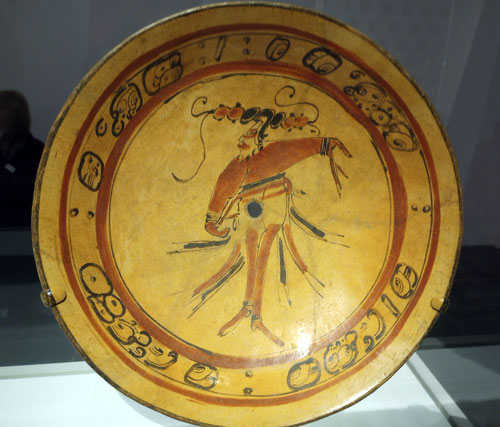
(600-900). Click image to enlarge.
This large plate depicts a startlingly modernist caricature of the Maize God dancing. The exaggerated shape and color silhouette remind me of 20th century cartoons by Ronald Searle, Gerald Scarfe and T. Hee. Or George Lichty, in the figure’s loose, disconnected lines and minimal brush strokes. There is wonderful spontaneity in the elegant figure’s expression of movement. Undulating lines in the god’s hairpiece suggest wind passing through corn stalk tassels and rounded kernels. Five panels flaring out from a protective belt, used by Mayan ballgame players, seem to be settling, indicating the fertility dance (or a movement within it) may have stopped abruptly. The god’s left arm strikes a strong pose with fingers outstretched, perhaps graphically expressing a fast upward gesture. Film animators often use similar “drag” or “smear” drawings when a character moves quickly from one main pose to another.
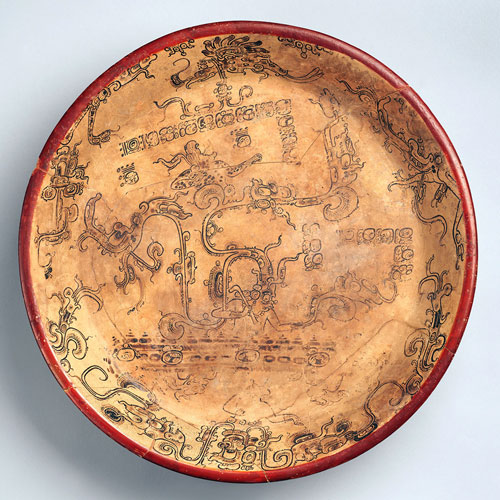
Guatemala or Mexico, 7th-8th century. Click image to enlarge.
The very name Chahk sounds like a crack of thunder in a tropical rainforest. The fearsome Rain God wields an axe to strike clouds to produce life-giving rain and thunder. Because the Mayans basic survival needs relied equally on rain and corn, they shared a reliance on and fervent devotion to both Rain God and Maize God. In this large (16 1/2 in. diameter), tripod feasting plate, Chahk is center-stage, dancing waist-deep in black primordial waters. The creatures slithering from him signify the birth of other deities, including the Maize God. This stunning drawing of detailed kinetic biomorphic designs is elegant, beautiful and psychedelic.
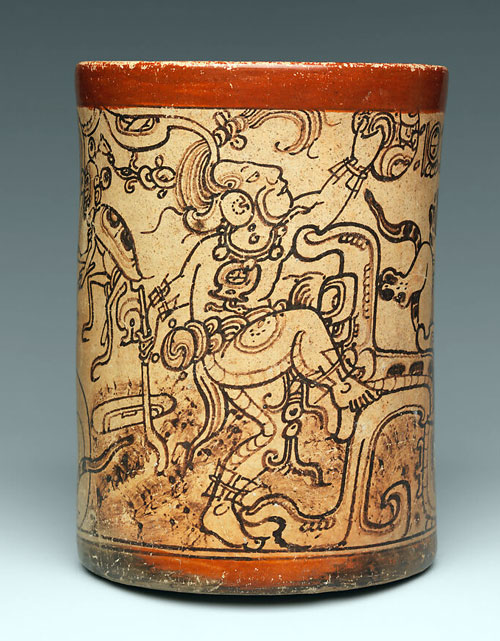
Attributed to the Metropolitan Painter (active 7th-8th century CE).
Click image to enlarge.
A masterful artist realistically captures Chahk the Rain God in a vigorous dance, thunder axe in one hand, a stone raised in the other. Hair tumbling with loose strands, his scant garment trails behind a hefty thigh. His skin folds mid-torso lend weight and physical veracity to the frozen action. Though human in form, visual clues show he is actually a superhuman associated with things aquatic: shiny fish scales shimmer behind his legs, a water plant grows from his forehead. Chahk’s expression is intense and focused, an action figure powerfully stomping out survival choreography. This highly detailed vessel image is delicately painted in the “codex” style. So named for its resemblance to Maya painted books, most of which were destroyed by the Spanish Conquest of the Maya region in the late 1500s. In an effort to eradicate the Mayan religion and history, Catholic zealots burned most of the documents; only four paper codices survive. The illustrations on ceramic cups and pottery give us an idea of their lively storytelling powers.
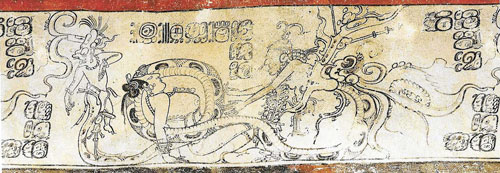
Rollout view of vessel with snake-lady scene.
Guatemala or Mexico, 650-800. Click image to enlarge.
Where there is a thunder and rain god, there is also K’awiil, the lightning lord of the skies. He is easily identified by a flame or smoke element emerging from his forehead, and especially the shape of a large snake grown out of one of his legs. The electric K’awiil strikes quickly, a serpent who affects human lives, like Mayan kings – those aggressive royal mortals who often used a sculpted image of K’awiil as a scepter, a symbol of their intimate connection with the gods. K’awiil’s electric powers are also linked to survival through fertility and abundance. This storytelling ceramic vessel depicts the seduction of a beautiful goddess ensnared by K’awiil’s serpent leg. From the snake’s huge mouth (far right) an old god emerges, reaching for the young woman. The hieroglyphic text refers to the birth of a god, the likely result of this forced encounter.
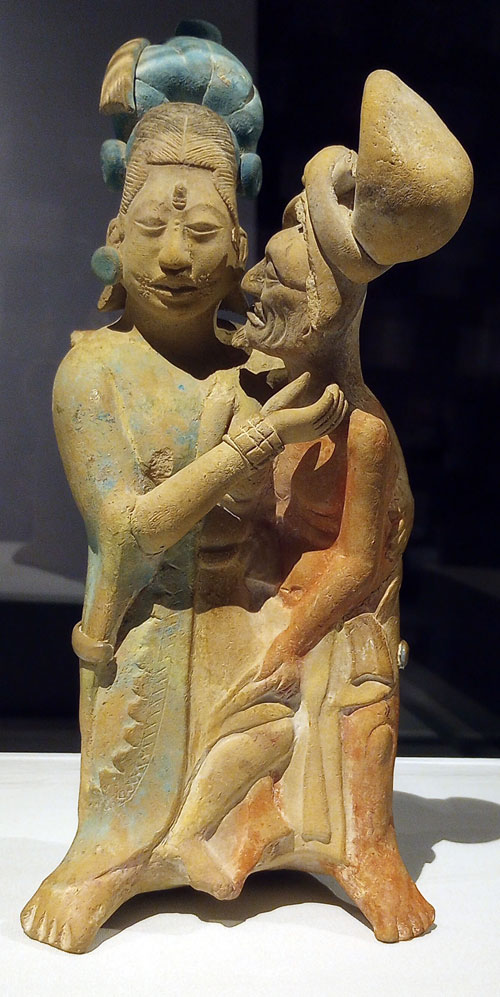
Mexico, 700-900. Terracotta, pigment. Click image to enlarge.
Old men embracing or attempting to seduce young women were a common subject of classic period Maya artists. Sometimes the woman depicted is the Moon Goddess, and the man her aged spouse, the Sun God. Sometimes it is a sexual encounter between mortals. Here, a small, wizened man gazes at a taller, voluptuous young woman as he lifts her skirt above the knee. She faces away from him, her raised arm and hand in a midway gesture that invites the viewer to speculate about their relationship. Will the gesture end in an affectionate caress or a sharp slap across the geezer’s wrinkled face? In other versions of this popular “embracing couple” sculpture, the woman’s hand gently touches the elder’s cheek as she returns his gaze. The gifted sculptor has brilliantly designed and staged the characters, allowing us to imagine the narrative. There is also an audio element: most of the vessel is hollow and can be used as a whistle or a musical instrument for ritual and pleasure.

c. A.D. 700-750.
Ceramic cup. Click image to enlarge.
The elder deity Itzam, wearing a pre-Columbian snood, teaches young men lessons about the creation cycle of the gods. There is much to admire in this beautiful, subtly caricatured drawing of the learning process. Teachers of any era can relate to the mood that the gifted (unknown) artist presents in two scenes of classroom knowledge transference. The silhouettes of the characters leaning in are strong as visual storytelling poses. Also, there is the stern facial expression of the hunched-over professor, looking intensely at his students, challenging their comprehension of the lessons. In one scene, Itzam speaks, while elegantly, casually gesturing with a writing instrument, toward a folded codex on the floor, as two circular speech lines (the birth of comic strip balloons) conjure arithmetical symbols. In a second scene, Itzam taps a thin finger on the floor to emphasize points as a glyph lecture emanates from his mouth, again via a dotted speech line. The attentive, respectful pupils soak up the master’s teachings. Stylish thick and thin painted outlines offer realistic anatomies of each individualized man; their torso skin folding over, their arms contrasting straight (bone) with rounded (muscle) shapes. This is an understated early example of the animation principle “stretch-and-squash,” which the great Disney film animator Milt Kahl admired in Degas nudes, where “you’ll have something that’s fairly straight and then, as the weight comes into it, you’ll get the bulging of the muscles . . . you’re making statements when you do that.”
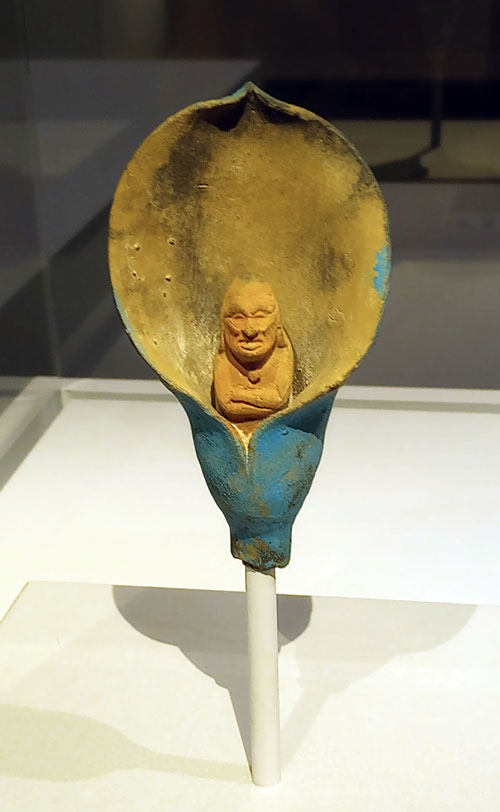
7th-9th century, Mexico. Click images to enlarge.


Below, LIDDED VESSEL with peccary, 4th century, Guatemala.
Click images to enlarge.
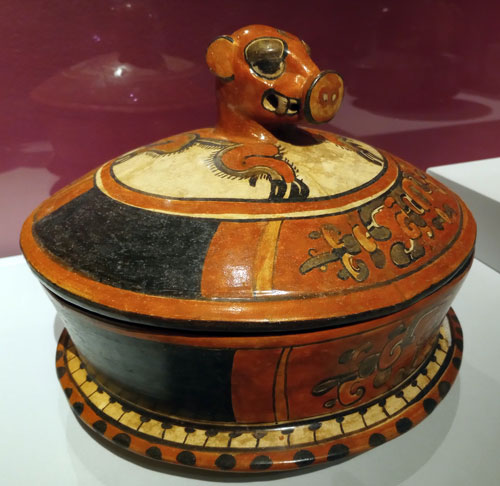
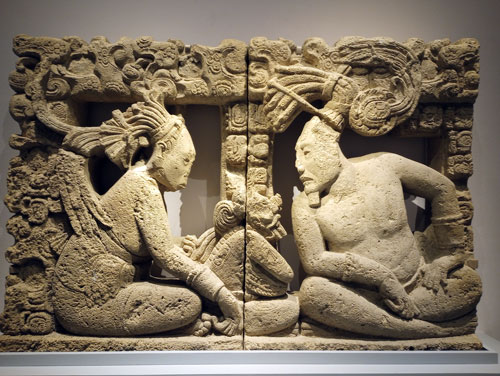
Guatemala or Mexico. Click image to enlarge.
A scene of quiet but intense concentration, or consultation, between three strongly silhouetted figures, masterfully sculpted in a limestone throne back. A bearded king (on the right) in the guise of the sky god Itzamnaaj, accompanied (on the left) by either his wife (or a courtier or a goddess) lean in to hear a small avian deity seated between them. The diminutive creature, a Pax God (named for the Mayan month of Pax) with its human body, winged arms and jaguar deity’s head, is a messenger from the sky god. This extraordinary artwork depicts the links between the Maya court and the supernatural world, the close relationship of kings to divine power. What message from the god might the royals be hearing? Perhaps a command regarding war and death, considering that the Pax deity was associated with war and blood sacrifice. Or maybe a subject more mundane? Note the woman’s gesture: the back of her left hand touches the Pax God. Is she gently comforting the visitor after its long journey? Or merely reiterating (for us the viewer) the equality and familiarity shared by Maya royalty and their gods.
For those of you who cannot see the exhibition Lives of the Gods: Divinity in Maya Art in person at the Met in New York (it closes April 2), here’s a link to an excellent 28-min video tour with two curators of the exhibition.
It is an informative virtual exploration of an exhibition of rarely seen masterpieces and recent discoveries tracing the life cycle of the gods, from the moment of their creation in a sacred mountain to their dazzling transformations as blossoming flowers or fearsome creatures of the night.
Enjoy!
*Note: The Jean Charlot Foundation has published Art from the Mayas to Disney online:
https://vault.jeancharlot.org/book/jean-charlot_text-ae.pdf
Hits: 58

